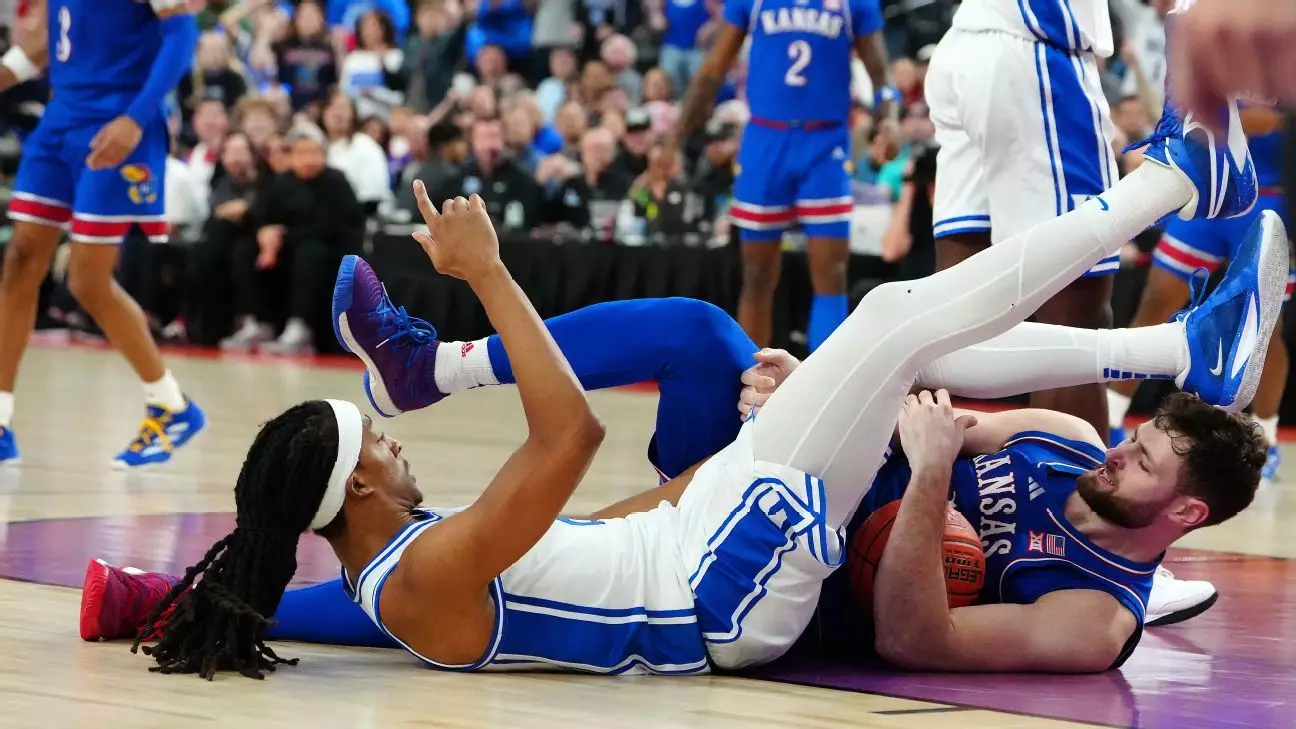The thrilling encounter between the Kansas Jayhawks and the Duke Blue Devils showcased not only basketball skill but also the consequences of player disruptions during critical moments. This match, which ended in a nail-biting 75-72 victory for Kansas, was marred by an incident involving star center Hunter Dickinson that raised questions about player safety, game integrity, and the varied interpretations of aggressive play.
The Incident: A Game-Changing Moment
Midway through the second half, Hunter Dickinson was ejected after a controversial play that saw him kick Duke’s Maliq Brown in the face while both players were on the floor. The incident occurred during a fight for a rebound after Dickinson missed a short jump hook. While both players wrestled for position, Dickinson’s kick, though seemingly unintentional, led to immediate scrutiny. After a lengthy evaluation by the officiating crew, Dickinson received a flagrant foul 2—an ejection marker under NCAA basketball rules.
Kansas head coach Bill Self expressed mixed feelings about the ruling. While he acknowledged the need for a penalty, he felt the severity was excessive. In his view, Dickinson deserved a flagrant foul 1 but not the harsher ejection. Self’s comments highlight the often subjective nature of officiating in high-stakes games, where calls can significantly impact the energy and flow of the competition.
On the opposing bench, Duke’s coach Jon Scheyer reflected a more decisive stance regarding the call. Although he only viewed the incident through a screen, he quickly sided with the officials’ decision. His agreement underscores the growing consensus that players must be held accountable for actions that can endanger their opponents, regardless of intent. The incident prompted discussions both during the game and post-match about the necessity of safeguarding player safety while maintaining competitive integrity.
The ejection left a significant void for the Jayhawks, who were clinging to a narrow 57-55 lead at that point in the game. Kansas players faced an uphill battle without Dickinson, who had contributed significantly until that moment, with 11 points and 6 rebounds. His absence not only changed the strategy for Kansas, but it also highlighted the fragility of basketball momentum, where one pivotal moment can shift the game’s tide.
The Athletic Response: Adaptation and Resilience
In Dickinson’s absence, backup center Flory Bidunga took on a larger role. The freshman stepped up with notable contributions, including 6 points and 8 rebounds in 16 crucial minutes. Bidunga’s performance proved vital for Kansas, helping them maintain composure amidst the tumult of the ejection. His ability to secure key offensive rebounds late in the game was crucial, revealing the potential for young players to rise under pressure when called upon. Senior forward KJ Adams Jr. lauded the freshman’s effort, emphasizing the importance of depth in a team’s roster—an aspect often overlooked in favor of star power.
As the game entered its dramatic conclusion, Duke managed to oscillate between heart-pounding moments, nearly taking the lead with several possessions in the closing minute. However, sloppy plays and missed opportunities, highlighted by turnovers, clearly illustrated how quickly fortunes can reverse in basketball. With Dickinson watching from the locker room, the tension was palpable as Kansas clung to their slim advantage.
This incident between Dickinson and Brown raises broader questions about the regulation of physical play within college basketball. Coaches and teams are continually grappling with how to balance aggressive defense while ensuring the safety of players. The outcome of one game can spark debates about potential rule revisions or adjustments in player training to minimize dangerous situations. As the sport evolves, so too must the guidelines that govern player interactions, ensuring the safety and enjoyment for both players and fans.
In retrospect, Dickinson’s ejection may serve a dual purpose: it not only addressed an immediate concern about player safety but also offered a teachable moment for future games. Teams, coaches, and players must navigate the fine line between aggression and discipline, balancing competitive spirit with a commitment to respecting the game and its participants. The Kansas-Duke matchup was thrilling, but it left significant lessons to be learned for all involved.


Leave a Reply